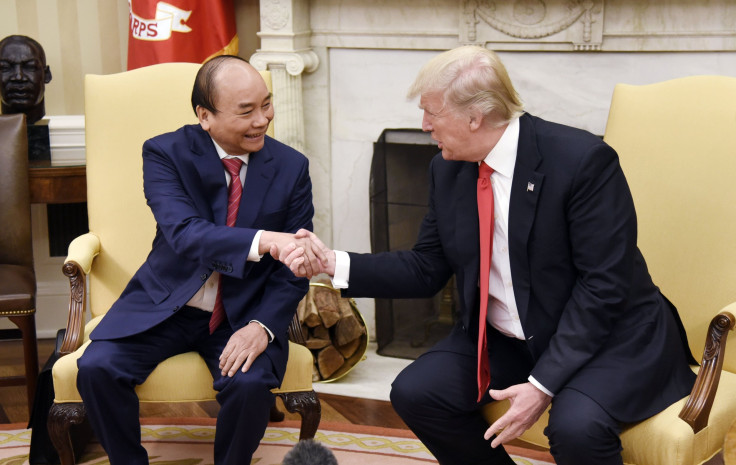Why Is US Sending An Aircraft Carrier To Vietnam?

President Donald Trump’s administration has decided to send over an aircraft carrier to visit Vietnam, one of the challengers to China’s claims over the South China Sea, in a sign of strengthening defense ties between the two countries. The carrier will arrive in Vietnam in 2018.
U.S. Defense Secretary Jim Mattis told Vietnamese Minister of National Defense Ngo Xuan Lich in Washington, Tuesday, that the U.S. and Vietnam have common interests, that is, to retain the freedom of navigation in the South China Sea in the face of an aggressive China.
"The Secretary welcomed Vietnam's engagement and growing leadership in the Asia-Pacific region," a statement from the Pentagon said.
Trump promised Vietnamese Prime Minister Nguyen Xuan Phuc, in an unofficial capacity on May 31, that he will be sending an American aircraft carrier over to Vietnam in the near future when Phuc became the first ASEAN leader to visit the White House after Trump's inauguration.
Read: Was Anthony Scaramucci Sacked Over His Relationship With Kimberly Guilfoyle?
Rodger Baker, vice president of strategic analysis at geopolitical intelligence firm Stratfor, said the meeting between Trump and Phuc was a carefully calculated move by the Trump administration with regards to building a defense against continuous efforts by China to militarize islands in the South China Sea.
"Vietnam sits in a very interesting position in Southeast Asia," Baker said. "Within the past week or so, Washington has delivered small vessels to the Vietnamese coast guard, there have been naval exchange visits (and) the U.S. has also waived some restrictions on arms exports to Vietnam."
After Phuc visited the White House, diplomatic relations between Vietnam and China deteriorated further. In June, Beijing became furious over Vietnam drilling for oil and gas in an offshore block that China claims to control.
Vietnam is a natural ally for the U.S. in confronting China's expansionist plans. Tensions between Vietnam and China are not new. The Vietnamese invaded Cambodia and ousted the Chinese-back murderous Khmer Rouge regime in 1978. Next year, China and Vietnam fought a month-long border war in which both sides claimed victories.
“Vietnam has always been the country in Asean that has the strongest suspicions of Beijing ... because it shares both a maritime and land border with China," Zhang Mingliang, a specialist on Southeast Asian affairs at Jinan University in Guangzhou, told the South China Morning Post.
Vietnam has also strenghtened its navy, fortified several islands, and been vocal on the international stage against Chinese claims in the South China sea.
When the Permanent Court of Arbitration in the Hague ruled in favor of the Philippines in its case against China in the South China Sea on July 12, Vietnam, the biggest supporter of Philippines on the issue, kept its cool instead of celebrating the indirect but nevertheless, strategic win against its rival.
Read: Video Shows Malia Obama Being Carted Out Of Lollapalooza In Chicago
It rightly predicted retaliation against the ruling from China, which shortly followed when the latter landed civilian aircraft on airstrips on two contested reefs, Subi and Mischief, Huffington Post reported. The Vietnamese Ministry of Foreign Affairs spokesman Le Hai Binh said of the incident: “Those actions conducted by China have seriously violated Vietnam’s sovereignty and are unlawful and cannot change the fact[s] about Vietnam’s sovereignty over the Hoang Sa and Truong Sa [known as Spratly and Paracel in China] archipelagoes.”
However, the U.S. would need to tread lightly in courting Vietnam as it needs China’s help in keeping the nuclear program of North Korea in check. On Saturday, the United Nations Security Council approved tougher sanctions against Kim Jong Un’s regime and China had a vital role in backing the deal.
Following the growing threat of North Korea, the U.S., in agreement with the Japanese government also relocated a major portion of the Navy carrier air wing from Naval Air Facility, Atsugi, Kanagawa to Marine Corps Air Station Iwakuni, Iwakuni city, Japan. Preparations for the same was made back in June and the first five E-2D early warning aircraft flew in on Wednesday.
“Everyone recognizes that the unity of the Japan-U.S. alliance is important more than ever when thinking about the security environment Japan is in, especially the circumstances involving ballistic-missile launches by North Korea,” Iwakuni Mayor Yoshihiko Fukuda said, Stripes reported.
© Copyright IBTimes 2025. All rights reserved.






















